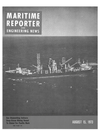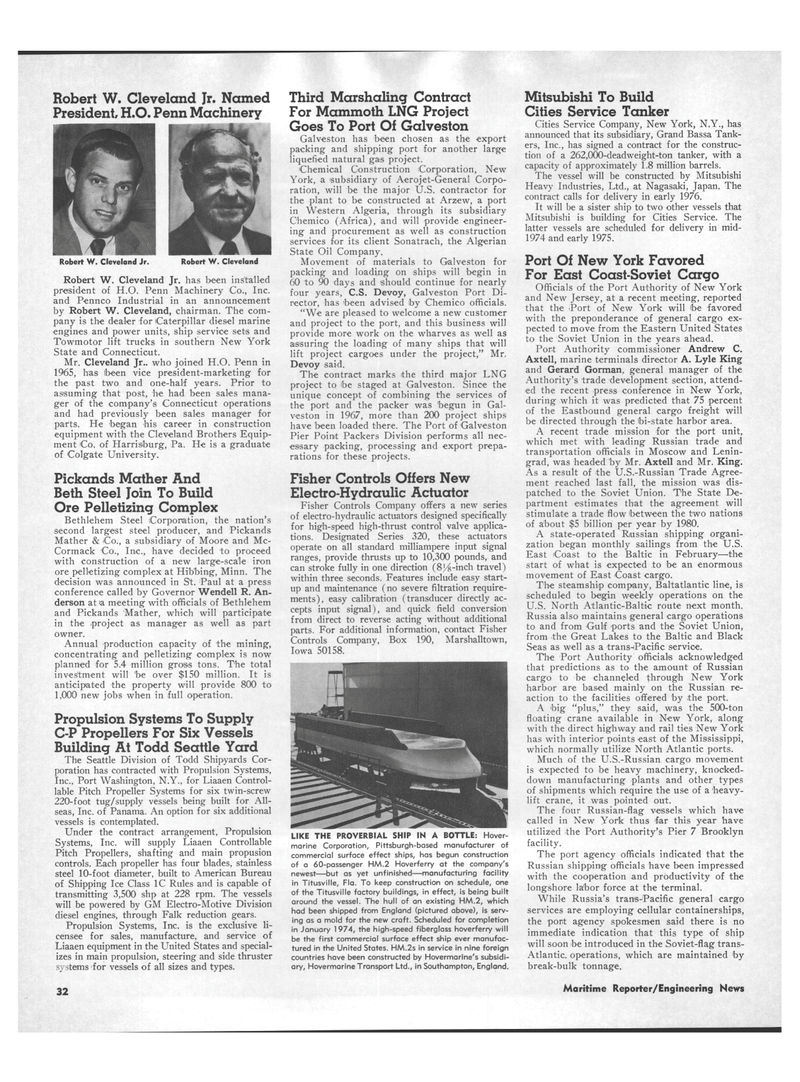
Page 28: of Maritime Reporter Magazine (August 15, 1973)
Read this page in Pdf, Flash or Html5 edition of August 15, 1973 Maritime Reporter Magazine
Robert W. Cleveland Jr. Named
President, H.O. Penn Machinery
Robert W. Cleveland
Robert W. Cleveland Jr. has been installed president of H.O. Penn Machinery Co., Inc. and Pennco Industrial in an announcement by Robert W. Cleveland, chairman. The com- pany is the dealer for Caterpillar diesel marine engines and power units, ship service sets and
Towmotor lift trucks in southern New York
State and Connecticut.
Mr. Cleveland Jr.. who joined H.O. Penn in 1965, has ibeen vice president-marketing for the past two and one-half years. Prior to assuming that post, he had been sales mana- ger of the company's Connecticut operations and had previously been sales manager for parts. He began his career in construction equipment with the Cleveland Brothers Equip- ment Co. of Harrisburg, Pa. He is a graduate of Colgate University.
Pickands Mather And
Beth Steel Join To Build
Ore Pelletizing Complex
Bethlehem Steel Corporation, the nation's second largest steel producer, and Pickands
Mather & Co., a subsidiary of Moore and Mc-
Cormack Co., Inc., have decided to proceed with construction of a new large-scale iron ore pelletizing complex at Hibbing, Minn. The decision was announced in S't. Paul at a press conference called by Governor Wendell R. An- derson at ia meeting with officials of Bethlehem and Pickands Mather, which will participate in the project as manager as well as part owner.
Annual production capacity of the mining, concentrating and pelletizing complex is now planned for 5.4 million gross tons. The total investment will 'be over $150 million. It is anticipated the property will provide 800 to 1,000 new jobs when in full operation.
Propulsion Systems To Supply
C-P Propellers For Six Vessels
Building At Todd Seattle Yard
The Seattle Division of Todd Shipyards Cor- poration has contracted with Propulsion Systems,
Inc., Port Washington, N.Y., for Liaaen Control- lable Pitch Propeller Systems for six twin-screw 220-foot tug/supply vessels being built for All- seas, Inc. of Panama. An option for six additional vessels is contemplated.
Under the contract arrangement, Propulsion
Systems, Inc. will supply Liaaen Controllable
Pitch Propellers, shafting and main propusion controls. Each propeller has four blades, stainless steel 10-foot diameter, built to American Bureau of Shipping Ice Class 1C Rules and is capable of transmitting 3,500 shp at 228 rpm. The vessels will be powered by GM Electro-Motive Division diesel engines, through Falk reduction gears.
Propulsion Systems, Inc. is the exclusive li- censee for sales, manufacture, and service of
Liaaen equipment in the United States and special- izes in main propulsion, steering and side thruster systems for vessels of all sizes and types.
Third Marshaling Contract
For Mammoth LNG Project
Goes To Port Of Galveston
Galveston has been chosen as the export packing and shipping port for another large liquefied natural gas project.
Chemical Construction Corporation, New
York, a 'subsidiary of Aerojet-General Corpo- ration, will be the major U.S. contractor for the plant to be constructed at Arzew, a port in Western Algeria, through its subsidiary
C'hemico (Africa), and will provide engineer- ing and procurement as well as construction services for its client Sonatrach, the Algerian
State Oil Company.
Movement of materials to Galveston for packing and loading on ships will begin in 60 to 90 days and should continue for nearly four years, C.S. Devoy, Galveston Port Di- rector, has been advised by Chemico officials. "We are pleased to welcome a new customer and project to the port, and this business will provide more work on the wharves as well as assuring the loading of many ships that will lift project cargoes under the project," Mr.
Devoy said.
The contract marks the third major LNG project to be staged at Galveston. Since the unique concept of combining the services of the port and the packer was begun in Gal- veston in 1967, more than 200 project ships have been loaded there. The Port of Galveston
Pier Point Packers Division performs all nec- essary packing, processing and export prepa- rations for these projects.
Fisher Controls Offers New
Electro-Hydraulic Actuator
Fisher Controls Company offers a new series of electro-hydraulic actuators designed specifically for high-speed high-thrust control valve applica- tions. Designated Series 320, these actuators operate on all standard milliampere input signal ranges, provide thrusts up to 10,300 pounds, and can stroke fully in one direction (8^-inch travel) within three seconds. Features include easy start- up and maintenance (no severe filtration require- ments), easy calibration (transducer directly ac- cepts input signal), and quick field conversion from direct to reverse acting without additional parts. For additional information, contact Fisher
Controls Company, Box 190, Marshalltown,
Iowa 50158.
LIKE THE PROVERBIAL SHIP IN A BOTTLE: Hover- marine Corporation, Pittsburgh-based manufacturer of commercial surface effect ships, has begun construction of a 60-passenger HM.2 Hoverferry at the company's newest—but as yet unfinished—manufacturing facility in Titusville, Fla. To keep construction on schedule, one of the Titusville factory buildings, in effect, is being built around the vessel. The hull of an existing HM.2, which had been shipped from England (pictured above), is serv- ing as a mold for the new craft. Scheduled for completion in January 1974, the high-speed fiberglass hoverferry will be the first commercial surface effect ship ever manufac- tured in the United States. HM.2s in service in nine foreign countries have been constructed by Hovermarine's subsidi- ary, Hovermarine Transport Ltd., in Southampton, England.
Mitsubishi To Build
Cities Service Tanker
Cities Service Company, New York, N.Y., has announced that its subsidiary, Grand Bassa Tank- ers, Inc., has signed a contract for the construc- tion of a 262,000-deadweight-ton tanker, with a capacity of approximately 1.8 million barrels.
The vessel will be constructed by Mitsubishi
Heavy Industries, Ltd., at Nagasaki, Japan. The contract calls for delivery in early 1976.
It will be a sister ship to two other vessels that
Mitsubishi is building for Cities Service. The latter vessels are scheduled for delivery in mid- 1974 and early 1975.
Port Of New York Favored
For East Coast-Soviet Cargo
Officials of the Port Authority of New York and New Jersey, at a recent meeting, reported that the Port of New York will be favored with the preponderance of general cargo ex- pected to move from the Eastern United States to the Soviet Union in the years ahead.
Port Authority commissioner Andrew C.
Axtell, marine terminals director A. Lyle King and Gerard Gorman, general manager of the
Authority's trade development section, attend- ed the recent press conference in New York, during which it was predicted that 75 percent of the Eastbound general cargo freight will be directed through the bi-state harbor area.
A recent trade mission for the port unit, which met with leading Russian trade and transportation officials in Moscow and Lenin- grad, was headed by Mr. Axtell and Mr. King.
As a result of the U.S.-Russian Trade Agree- ment reached last fall, the mission was dis- patched to the Soviet Union. The State De- partment estimates that the agreement will stimulate a trade flow between the two nations of about $5 billion per year by 1980.
A state-operated Russian shipping organi- zation began monthly sailings from the U.S.
East Coast to the Baltic in February—the start of what is expected to be an enormous movement of East Coast cargo.
The steamship company, Baltatlantic line, is scheduled to begin weekly operations on the
U.S. North Atlantic-Baltic route next month.
Russia also maintains general cargo operations to and from Gulf ports and the Soviet Union, from the Great Lakes to the Baltic and Black
Seas as well as a trans-Pacific service.
The Port Authority officials acknowledged that predictions as to the amount of Russian cargo to be channeled through New York harbor are based mainly on the Russian re- action to the facilities offered by the port.
A big "plus," they said, was the 500-ton floating crane available in New York, along with the direct highway and rail ties New York has with interior points east of the Mississippi, which normally utilize North Atlantic ports.
Much of the U.S.-Russian cargo movement is expected to be heavy machinery, knocked- down manufacturing plants and other types of shipments which require the use of a 'heavy- lift crane, it was pointed out.
The four Russian-flag vessels which have called in New York thus far this year have utilized the Port Authority's Pier 7 Brooklyn facility.
The port agency officials indicated that the
Russian shipping officials have been impressed with the cooperation and productivity of the longshore labor force at the terminal.
While Russia's trans-Pacific general cargo services are employing cellular containerships, the port agency spokesmen said there is no immediate indication that this type of ship will soon be introduced in the Soviet-flag trans-
Atlantic. operations, which are maintained by break-bulk tonnage.
Robert W. Cleveland Jr. 32 Maritime Reporter/Engineering News

 27
27

 29
29
